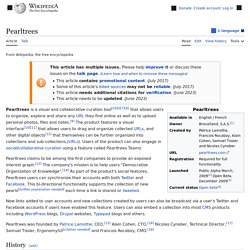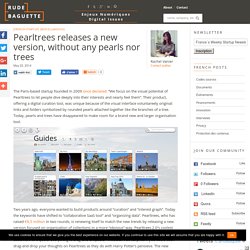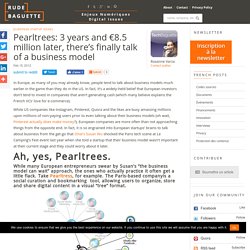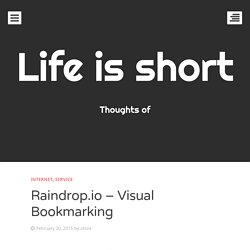

Pearltrees. Pearltrees refers to itself as "a place for your interests".[7] Functionally the product is a visual and collaborative curation tool[8][9][10][11] that allows users to organize, explore and share any URL they find online as well as to upload personal photos, files and notes.[12] The product features a unique visual interface[13][14] that allows users to drag and organize collected URLs, and other digital objects.[15] that themselves can be further organized into collections and sub-collections,[16] (URLs).

Users of the product can also engage in social/collaborative curation using a feature called Pearltrees Teams.[17] Pearltrees was founded by Patrice Lamothe, CEO,[21] Alain Cohen, CTO,[22] Nicolas Cynober, Technical Director,[23] Samuel Tissier, Ergonomy/UI[24] and Francois Rocaboy, CMO.[25] History[edit] Development of Pearltrees began in 2007.
2014/05 Pearltrees Radically Redesigns Its Online Curation Service To Reach A Wider Audience. Pearltrees, the Paris-based online curation service that launched in late 2009, was always known for its rather quirky Flash-based interface that allowed you to organize web bookmarks, photos, text snippets and documents into a mindmap-like structure.

For users who got that metaphor, it was a very powerful service, but its interface also presented a barrier to entry for new users. Today, the company is launching a radical redesign that does away with most of the old baggage of Pearltrees 1.0. Gone are the Flash dependency, the tree diagrams, the little round pearls that represented your content and most everything else from the old interface.
Here is what Pearltrees 1.0 looked like: And here is the new version: Pearltrees’ mission is still to allow you to organize everything you want on the service (in that respect, it almost competes with Evernote). 2014/05 Pearltrees releases a new version, without any pearls nor trees. The Paris-based startup founded in 2009 once declared: “We focus on the visual potential of Pearltrees to let people dive deeply into their interests and nearly feel them”.

Their product, offering a digital curation tool, was unique because of the visual interface voluntareely original: links and folders symbolized by rounded pearls attached together like the branches of a tree. Today, pearls and trees have disappeared to make room for a brand new and larger organisation tool. Two years ago, everyone wanted to build products around “curation” and “interest graph”. Today the keywords have shifted to “collaborative SaaS tool” and “organizing data”. Pearltrees, who has raised €8,5 million in two rounds, is renewing itself to match the new trends by releasing a new version focused on organization of collections in a more “obvious” way. Why giving up the core of the product, after 4,5 years of existence and 1,7 million users? 2012/02 Pearltrees: 3 years and €8.5 million later, there's finally talk of a business model. In Europe, as many of you may already know, people tend to talk about business models much earlier in the game than they do in the US.

In fact, it’s a widely-held belief that European investors don’t tend to invest in companies that aren’t generating cash (which many believe explains the French VCs’ love for e-commerce). While US companies like Instagram, Pinterest, Quora and the likes are busy amassing millions upon millions of non-paying users prior to even talking about their business models (oh wait, Pinterest actually does make money?) , European companies are more often than not approaching things from the opposite end. In fact, it is so engrained into European startups’ brains to talk about business from the get-go that Ohai’s Susan Wu shocked the Paris tech scene at Le Camping’s Fest event last year when she told a startup that their business model wasn’t important at their current stage and they could worry about it later.
2015/06 Annotaryの使い方 – GINNOZA. Raindrop.io – Visual Bookmarking. インターネットでは次々とサービスが生まれては消えていく。

ソフトウェアの世界は、プログラムを書く知識さえあればどんなアイデアもたった1人で作り上げることができる。 そしてここにまた新しいサービスを発見した。 Raindrop.ioだ。 サービスのジャンルとしてはオンラインブックマークと言える。 かなりビジュアルと使いやすさに凝っていて、ウェブブラウザ拡張による登録もスムーズでヌルヌルだ。 ただのブックマーク管理ではなく、ブックマークをタイプ別に登録でき、記事ならページのテキスト、動画ページなら動画部分(おそらくembed)などを最適化したものを同時に保存する。 オンラインブックマーク系はDeliciousしか使ったことがないので、はてなブックマーク(ブックマークと呼んでよいのかも疑問)などがどんな機能なのかは知らない。 サービス開始は2013年のようだが、まだまだ知名度、ユーザー数も始まったばかりのステージ。 まだユーザー数は5万人ちょっと。 Pinback - The backup and export tool Pinterest forgot.